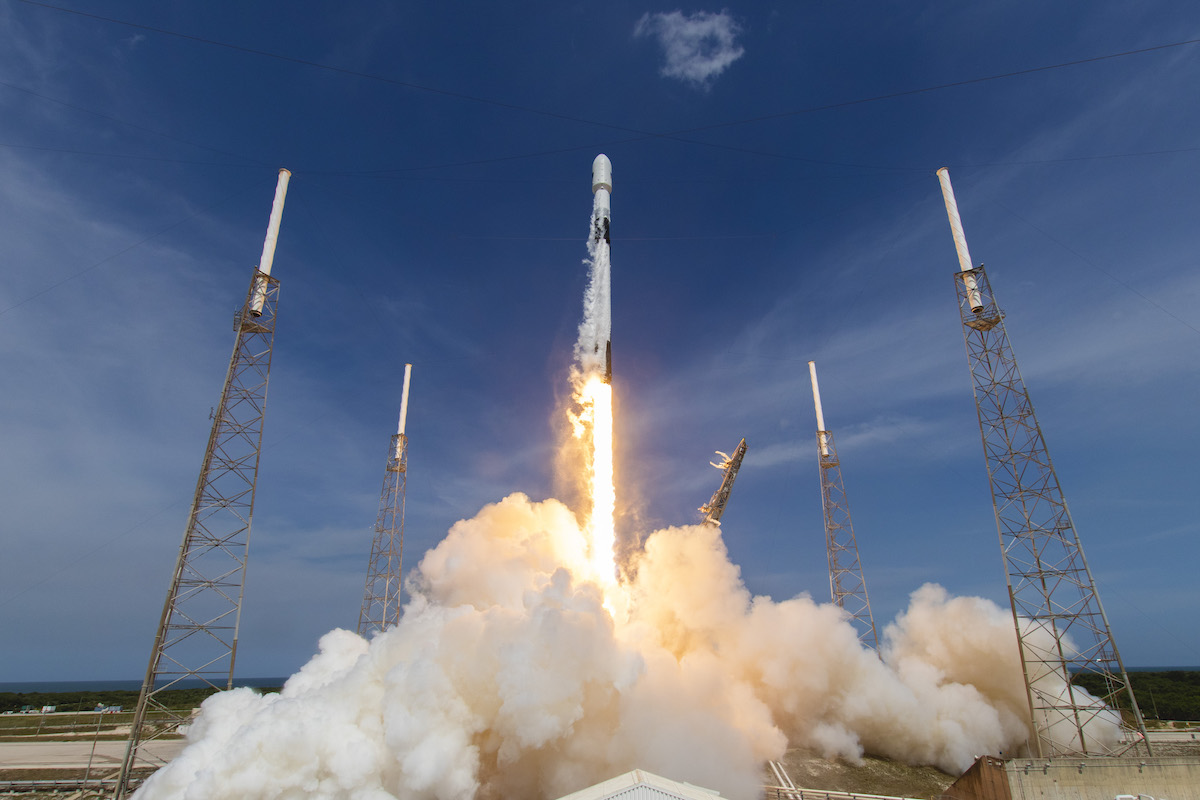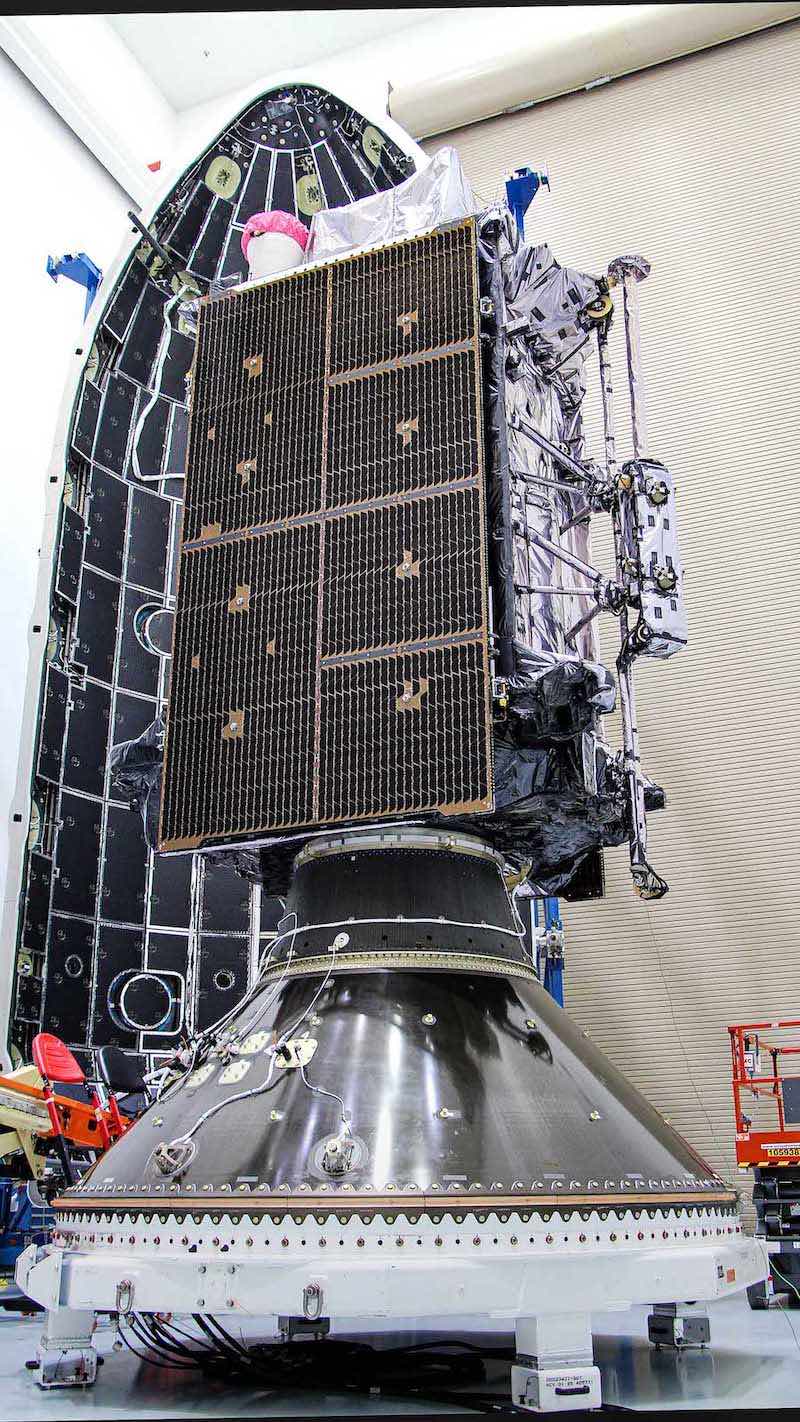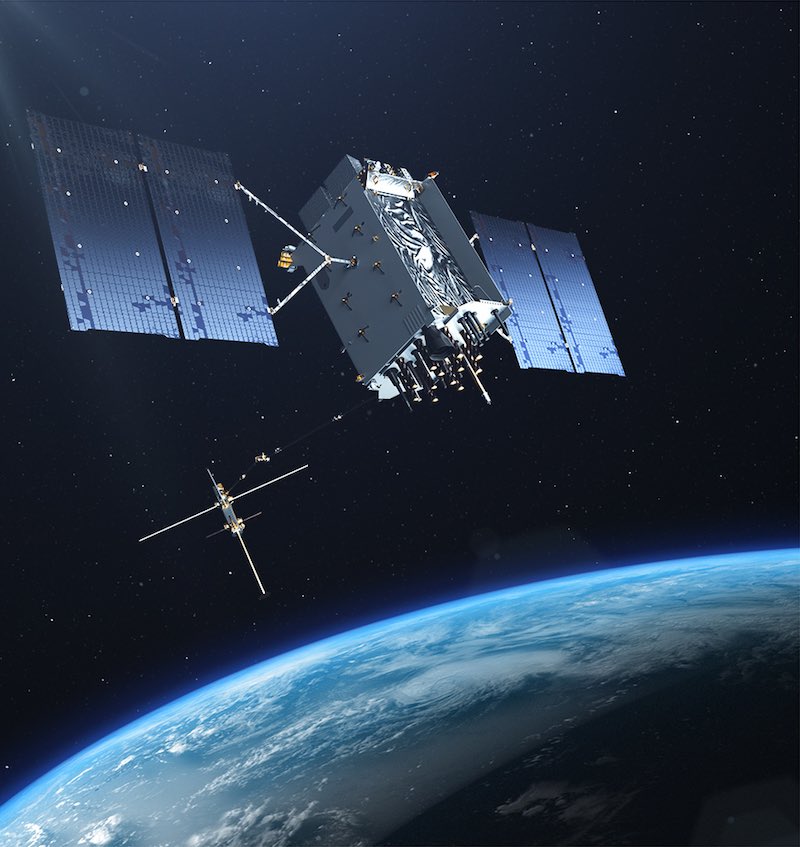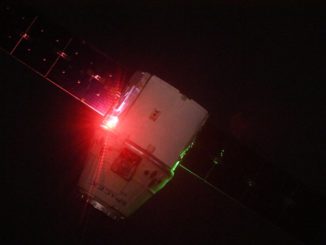
A new GPS satellite rocketed into orbit from Cape Canaveral on top of a SpaceX Falcon 9 launcher Tuesday on the way to replace one of the more than 30 other spacecraft helping guide everything from military munitions to motorists.
The launch was the first by SpaceXs for the U.S. Space Force, which took over most Air Force-run space programs after its establishment as a new military service in December. The third in a new line of upgraded Global Positioning System navigation satellites flew aboard the Falcon 9 rocket, adding fresh capabilities to the GPS network while replacing an aging spacecraft launched more than 20 years ago.
“The GPS 3 program continues to build on its successes by delivering advanced capabilities for the United States Space Force, and maintaining the ‘gold standard’ for position, navigation and timing.” said Col. Edward Byrne, Medium Earth Orbit Space Systems Division chief at the Space and Missile Systems Center.
The third GPS 3-series satellite, designated GPS 3 SV03, took off at 4:10:46 p.m. EDT (2010:46 GMT) from pad 40 at Cape Canaveral Air Force Station in Florida.
Riding a 229-foot-tall (70-meter) Falcon 9 rocket, the 9,505-pound (4,311-kilogram) spacecraft launched on a trajectory toward the northeast from Cape Canaveral, flying roughly parallel to the U.S. East Coast.
Nearly 90 minutes after liftoff, the Falcon 9’s upper stage precisely released the GPS 3 SV03 satellite into an on-target transfer orbit ranging in altitude between around 250 miles (400 kilometers) and 12,550 miles (20,200 kilometers), with an inclination of 55 degrees to the equator.
The spot-on orbit puts the GPS 3 SV03 spacecraft in position to use its own propulsion system in the coming weeks to circularize its orbit at an altitude of 12,550 miles, where the satellite is set to enter the operational GPS constellation as early as August, military officials said.
The launch was originally scheduled for late April, but military officials delayed the flight two months to allow time for teams at a satellite operations center in Colorado to introduce and test new protocols to enable physical distancing between control consoles. Officials reduced the size of the crew inside the control center, and added partitions and procured personal protective equipment for satellite controllers to reduce risks amid the coronavirus pandemic, according to Byrne.
Here’s a replay of the Falcon 9 launch with the GPS 3 SV03 satellite. https://t.co/IJZ8yUwa6U pic.twitter.com/NGgOuzeyDM
— Spaceflight Now (@SpaceflightNow) June 30, 2020
Manufactured by Lockheed Martin, the GPS 3 SV03 satellite is set to enter service in Plane E, Slot 4 of the GPS constellation. That position is currently occupied by a GPS satellite launched May 10, 2000, from Cape Canaveral on a Delta 2 rocket. Military officials did not say whether that satellite, which was originally designed for a 10-year mission, will be decommissioned or moved to another slot in the GPS network.
Lockheed Martin confirmed in a statement after Tuesday’s launch that the GPS 3 SV03 spacecraft was responding to commands from engineers at the company’s Launch and Checkout Center in Denver.
The GPS satellites are spread among six orbital planes, each with four primary spacecraft, plus spares. Byrne said Friday in a pre-launch teleconference with reporters that the GPS constellation currently consists of 31 satellites.
The GPS network provides positioning and timing services worldwide for military and civilian users, beaming signals relied upon by airliners, ATMs, drivers and smart bombs, among numerous other users.
“The Global Positioning System has become part of our critical national infrastructure, from transportation to financial markets to energy grids to the rideshare industry,” said Tonya Ladwig, acting vice president of Lockheed Martin’s navigation systems division. “It’s no longer a matter of did you use GPS today. It’s a matter of how many times did you actually use it.”
With an estimated 4 billion users, the GPS network reached full operational capability in 1995. The military has conducted a series of launches to replenish the GPS satellite fleet since then, using ULA’s Atlas and Delta rockets, and now SpaceX’s Falcon 9.
The GPS 3 satellites provide more accurate navigation signals and boasting longer design lifetimes of 15 years. The new GPS 3 satellites also broadcast e a new L1C civilian signal that is compatible with Europe’s Galileo network and Japan’s Quasi-Zenith Satellite System.
Military officials say the compatibility of GPS signals with satellite navigation networks operated by allies maximizes the accuracy of positioning and timing signals, helping ensure that users can fix their locations through more spacecraft in the sky at one time.

Like the previous line of Boeing-built GPS 2F satellites, all GPS 3-series spacecraft broadcast a dedicated L5 signal geared to support air navigation. The GPS 3 satellites also continue beaming an encrypted military-grade navigation signal known as M-code.
The M-code signal allows GPS satellites to broadcast higher-power, jam-resistant signals over specific regions, such as a military theater or battlefield. The capability provides U.S. and allied forces with more reliable navigation services, and could also allow the military to intentionally disrupt or jam civilian-grade GPS signals in a particular region, while the M-code signal remains unimpeded.
L3Harris Technologies builds the navigation payloads for the GPS 3 satellites.
The first two GPS 3-series satellites launched in December 2018 on a SpaceX Falcon 9 rocket and last August aboard a United Launch Alliance Delta 4 booster. Both were declared fully operational earlier this year.
Ladwig said the GPS 3 SV04 and SV05 spacecraft are complete and in storage awaiting launch, and the next three satellites are fully assembled and undergoing environmental testing. SV09 and SV10 are currently being assembled at Lockheed Martin’s GPS satellite factory near Denver.
Lockheed Martin is on contract with the Defense Department to build 10 GPS 3 satellites — two of which have launched — and up to 22 upgraded GPS 3F-series satellites.
The Space Force has reserved the next three GPS 3-series satellite launches with SpaceX. An SMC spokesperson said the GPS SV04 mission is set for launch no earlier than Sept. 30, followed by SV05 in January 2021.
Flying 2,600 miles (4,200 kilometers) over the Pacific Ocean, SpaceX’s Falcon 9 rocket has deployed the US military’s GPS 3 SV03 navigation satellite into an on-target orbit.
The satellite will boost itself into the GPS network to begin a 15-year mission. https://t.co/IJZ8yUwa6U pic.twitter.com/bW5Lg49oAw
— Spaceflight Now (@SpaceflightNow) June 30, 2020
Tuesday’s launch also marked the first time military officials allowed SpaceX to reserve enough propellant on the rocket to land the Falcon 9’s first stage booster after a launch of a high-priority national security payload.
The Falcon 9 booster touched down on SpaceX’s drone ship “Just Read The Instructions” positioned around 400 miles (630 kilometers) northeast of Cape Canaveral in the Atlantic Ocean.
The first stage fired its engines to guide itself toward the drone ship after separation from the Falcon 9’s upper stage around two-and-a-half minutes into the mission. Titanium grid fins helped stabilize the rocket during descent, and booster landed on the power of its center engine around eight-and-a-half minutes after launch.
It was a crucial recovery for SpaceX, which aims to reuse the booster on a future flight. The first stage used Tuesday was a brand new booster.
SpaceX also retrieved the two halves of the Falcon 9 rocket’s payload fairing after Tuesday’s mission. Two recovery ships pulled the fairing halves from the Atlantic Ocean for potential reuse.
Mission planners modified the Falcon 9 launch profile to accommodate the booster landing.
The launch profile adjustment to make landing of the Falcon 9 booster possible ended up saving “several million dollars” for the military from the original SpaceX launch contract value of $96.5 million, according to Walter Lauderdale, mission director for the GPS SV03 launch from the Space Force’s Space and Missile Systems Center.
On SpaceX’s first launch of a GPS navigation satellite in December 2018, military officials required the launch company to devote all of the Falcon 9 rocket’s capacity to placing the spacecraft into orbit. That meant SpaceX could not install landing legs on the Falcon 9’s first stage or attempt recovery of the booster.
SpaceX lands, refurbishes and re-flies Falcon 9 first stages to reduce costs, and it is the only launch company that currently reuses rocket hardware.
SpaceX has recovered rockets on previous launches with military payloads, such as a Falcon Heavy mission last June, but those missions carried experimental technology demonstration and research satellites — not operational spacecraft like a GPS satellite.
On SpaceX’s first GPS launch in 2018, the military required the Falcon 9 rocket to place the spacecraft into an orbit with a higher perigee, or low point, of more than 740 miles, or about 1,200 kilometers. Teams also loaded extra fuel into the GPS spacecraft as an extra precaution.
It was the first high-priority national security payload to launch on a SpaceX rocket, and it was also the first satellite in a new design of GPS spacecraft.
“Simply put, there was insufficient performance given the mission trajectory and payload weight, combined with the uncertainties associated with this demanding mission,” Lauderdale said.
“Our evaluation of that mission’s performance, combined with additional work with SpaceX, reduced uncertainty in many areas,” Lauderdale said. “When we approached SpaceX to revise some spacecraft requirements for this mission … they responded with an opportunity to recover the booster in exchange for adding these requirements, as well as other considerations.”

Officials are now more comfortable with the performance of the Falcon 9 rocket and the new GPS 3-series satellite design. That allowed engineers to load less propellant into the third GPS 3 satellite.
Mission planners also changed the perigee of the spacecraft’s initial orbit after launch from around 740 miles to 250 miles, according to Byrne.
“All that required from us was to reassess our burn profile, so we made some slight modifications to that burn profile, but there’s been no mission impact associated with the booster recovery option,” Byrne said in a pre-launch conference call with reporters.
One change to the Falcon 9 rocket for the GPS SV03 mission was a gray band of thermal insulation on the launcher’s upper stage. The thermal layer was designed to help maintain kerosene fuel at proper temperatures during a nearly one-hour coast phase between the first and second burns of the upper stage’s Merlin engine, and then keep propellants stable during another coast phase of several hours before a third Merlin burn to deorbit the stage.
SpaceX has tested the thermal layer before, but it did not fly on the first GPS 3 launch in 2018. The company has experimented with long-duration coasts of the Falcon upper stage to gather data before the first dedicated launch of a national security payload on SpaceX’s triple-core Falcon Heavy rocket late this year.
Military engineers charged with overseeing the design and production of SpaceX rockets for national security missions assessed numerous configuration changes since the Falcon 9’s first launch of a GPS satellite in 2018.
“Since the GPS 3 launch in December 2018, we’ve worked with SpaceX to stay current on the configuration of the Falcon 9, evaluating 665 changes,” Lauderdale said. “This enabled us to maintain the vehicle technical baseline that is the foundation of our independent mission assurance.”
Space Force officials have not yet approved SpaceX to launch critical military satellites — a mission class known as National Security Space Launch payloads — using previously-flown boosters. SpaceX has re-launched Falcon boosters 37 times to date with a 100 percent success record.
Lauderdale said the SMC mission assurance team is becoming more familiar with how SpaceX refurbishes rockets in between flights.
“I can’t commit to when we’ll be ready,” he said Friday, referring to when the military could launch a national security payload on a reused Falcon 9 booster.
SpaceX is building an all-new Falcon Heavy rocket for a national security launch late this year, and the company is expected to use a brand new booster for the next GPS launch no earlier than Sept. 30.
The military is currently considering proposals from four companies — SpaceX, ULA, Blue Origin and Northrop Grumman — in the next round of launch service procurements. Lauderdale said the military will allow launch service providers who win the the so-called “Phase 2” contracts to bid reused rockets for national security space launches in an effort to reduce costs.
“As a program, we are open and ready and looking forward to whatever industry wants to make available to us, but predominately we’ve been looking at the Phase 2 competition as that opportunity,” Lauderdale said.
With the GPS launch behind them, SpaceX teams on Florida’s Space Coast will again turn their attention to launching a Falcon 9 rocket pad 39A at NASA’s Kennedy Space Center with the next batch of SpaceX’s Starlink Internet satellites.
That mission was supposed to launch Friday, June 26, but SpaceX scrubbed the launch attempt and postponed the flight until after the GPS launch from nearby pad 40. A launch hazard area warning notice released Tuesday for sailors off Florida’s Space Coast suggested the next Falcon 9/Starlink launch has been rescheduled for Wednesday, July 8.
Email the author.
Follow Stephen Clark on Twitter: @StephenClark1.



